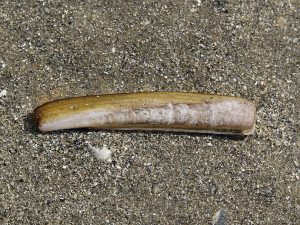I was watching No Reservations recently and noticed that Anthony was eating some kind of mollusk in a long straight shell. He described it as a razor clam. This is an unremarkable observation in and of itself.
However, the shell was very familiar to me, and I eventually pieced together why.
I was in an especially anti-Boomer mood for some reason (easy to do when the internal monologue digs up resentment towards American economics, and Anthony Bourdain was doing one of his self-gratification episodes). And so my thoughts had turned towards my wife’s aunt, who is in many ways the personification of Boomerism. While quite kind in her own way, she has a predilection for Boomer opinion stereotypes, such as taking hearsay at face value, and maintaining a preference for mediocre chain restaurants that serve needlessly large portions.

I’ll chalk that last one up to simple generational preferences, and the fact that she doesn’t enjoy cooking. You can’t really blame someone who doesn’t like to cook for their pre-prepared food preferences. But it’s that first observation that’s the theme of this post.
The other reason she came to mind was that she is a resident of St. Augustine, FL – and the place where I first saw these clam shells. She also told me that it was illegal to pick up rocks off the beach and take them home when we last visited. I refer specifically to coquina – those cool rocks of compressed shells that the Spanish used to build forts out of.
But back to the clam. The shells of these creatures were all over the Atlantic Florida beaches. Not knowing them for what they were, I was informed by said aunt that they were the hardened outer skins of mangroves. I did not question this, probably because I was on vacation and intentionally trying to avoid thinking too much.
A brief internet search revealed that the Atlantic Jackknife Clam (a type of razor clam, which I already linked to above), is indeed a very common shell to find on the Atlantic beaches, and there were no apparent references to petrified mangroves.
I then attempted to determine definitively if picking up coquina from the beaches of St. Augustine was in fact illegal. I found two references to the topic that said yes it is: 1) A personal blog by a resident, and 2) A private local newspaper that didn’t cite any legal statutes. The examples given in both were extreme, claiming that tourists go out to the beaches and chip lots of coquina away from major outcroppings. A somewhat different situation than some guy who picked up a rock sitting on the sand.
I also found out that commercial licenses are issued for the wholesale harvesting of coquina for the purpose of selling it to tourists. This leads me to believe that there are no environmental or archaeological concerns involved, and that it’s simply control of local economics. So locals don’t like tourists, but have no problem with taking their money. I’d hazard to say that this is common sentiment amongst small communities in desirable locations.
She had tricked me into not keeping a cool clam shell I found because I falsely believed that it was an unremarkable sliver of wood that would just dry out and rot away. But I didn’t believe taking a rock was illegal, so when she wasn’t looking I pilfered a sizeable chunk.

And here it sits on my deck now.
I’m still not convinced that taking it was illegal, both because of the misinformation I already received and that the only internet references I can find to this mysterious rule exist on non-credible websites. It wouldn’t surprise me if she was just messing with me, but I’d equally believe she took these fallacies herself to be truth.
Boomers, right?
–Simon

